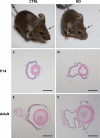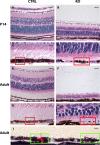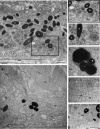Selective Ablation of Megalin in the Retinal Pigment Epithelium Results in Megaophthalmos, Macromelanosome Formation and Severe Retina Degeneration
- PMID: 30665232
- PMCID: PMC6343679
- DOI: 10.1167/iovs.18-25667
Selective Ablation of Megalin in the Retinal Pigment Epithelium Results in Megaophthalmos, Macromelanosome Formation and Severe Retina Degeneration
Abstract
Purpose: Mutations in the megalin-encoding gene, LRP2, cause high myopia as seen in patients suffering from Donnai-Barrow/facio-oculo-acoustico-renal syndrome. Megalin is present in both the nonpigmented epithelium of the ciliary body and in the RPE. In this study, we set out to establish an animal model to study the mechanisms underlying the ocular phenotype and to establish if high myopia/megaophthalmos is induced by postnatal megalin-deficiency in the RPE.
Methods: Postnatal RPE-specific deletion of megalin was generated by crossing mice bearing a homozygous loxP-flanked Lrp2 allele with transgenic mice expressing the Cre recombinase driven by the BEST1 promotor. The model was investigated by immunohistologic techniques, and transmission electron microscopy.
Results: Mice with postnatal RPE-specific loss of megalin developed a megaophthalmos phenotype with dramatic increase in ocular size and severe retinal thinning associated with compromised vision. This phenotype was present at postnatal day 14, indicating rapid development in the period from onset of BEST1 promotor activity at postnatal day 10. Additionally, RPE melanosomes exhibited abnormal size and morphology, suggested by electron tomography to be caused by fusion events between multiple melanosomes.
Conclusions: Postnatal loss of megalin in the RPE induces dramatic and rapid ocular growth and retinal degeneration compatible with the high myopia observed in Donnai-Barrow patients. The morphologic changes of RPE melanosomes, believed to be largely inert and fully differentiated at birth, suggested a continued plasticity of mature melanosomes and a requirement for megalin to maintain their number and morphology.
Figures






Similar articles
-
Megalin-deficiency causes high myopia, retinal pigment epithelium-macromelanosomes and abnormal development of the ciliary body in mice.Cell Tissue Res. 2014 Oct;358(1):99-107. doi: 10.1007/s00441-014-1919-4. Epub 2014 Jul 1. Cell Tissue Res. 2014. PMID: 24980834 Free PMC article.
-
Conditional loss of Kcnj13 in the retinal pigment epithelium causes photoreceptor degeneration.Exp Eye Res. 2018 Nov;176:219-226. doi: 10.1016/j.exer.2018.07.014. Epub 2018 Jul 25. Exp Eye Res. 2018. PMID: 30009826 Free PMC article.
-
An efficient inducible RPE-Selective cre transgenic mouse line.Exp Eye Res. 2021 Jan;202:108370. doi: 10.1016/j.exer.2020.108370. Epub 2020 Nov 29. Exp Eye Res. 2021. PMID: 33264655 Free PMC article.
-
Foxg1-Cre Mediated Lrp2 Inactivation in the Developing Mouse Neural Retina, Ciliary and Retinal Pigment Epithelia Models Congenital High Myopia.PLoS One. 2015 Jun 24;10(6):e0129518. doi: 10.1371/journal.pone.0129518. eCollection 2015. PLoS One. 2015. PMID: 26107939 Free PMC article.
-
A review of Donnai-Barrow and facio-oculo-acoustico-renal (DB/FOAR) syndrome: clinical features and differential diagnosis.Birth Defects Res A Clin Mol Teratol. 2009 Jan;85(1):76-81. doi: 10.1002/bdra.20534. Birth Defects Res A Clin Mol Teratol. 2009. PMID: 19089858 Free PMC article. Review.
Cited by
-
Vascular endothelial growth factor from retinal pigment epithelium is essential in choriocapillaris and axial length maintenance.PNAS Nexus. 2022 Aug 24;1(4):pgac166. doi: 10.1093/pnasnexus/pgac166. eCollection 2022 Sep. PNAS Nexus. 2022. PMID: 36714840 Free PMC article.
-
Histology and clinical imaging lifecycle of black pigment in fibrosis secondary to neovascular age-related macular degeneration.Exp Eye Res. 2022 Jan;214:108882. doi: 10.1016/j.exer.2021.108882. Epub 2021 Dec 8. Exp Eye Res. 2022. PMID: 34890604 Free PMC article.
-
Immunoglobulin G Is a Novel Substrate for the Endocytic Protein Megalin.AAPS J. 2021 Mar 7;23(2):40. doi: 10.1208/s12248-021-00557-1. AAPS J. 2021. PMID: 33677748
-
LRP2 is a potential molecular target for nonsyndromic pathological myopia.JCI Insight. 2025 Jun 24;10(15):e192929. doi: 10.1172/jci.insight.192929. eCollection 2025 Aug 8. JCI Insight. 2025. PMID: 40553567 Free PMC article.
-
IMI 2021 Yearly Digest.Invest Ophthalmol Vis Sci. 2021 Apr 28;62(5):7. doi: 10.1167/iovs.62.5.7. Invest Ophthalmol Vis Sci. 2021. PMID: 33909031 Free PMC article. Review.
References
-
- Patel N, Hejkal T, Katz A, Margalit E. Ocular manifestations of Donnai-Barrow syndrome. J Child Neurol. 2007;22:462–464. - PubMed
-
- Schrauwen I, Sommen M, Claes C, et al. Broadening the phenotype of LRP2 mutations: a new mutation in LRP2 causes a predominantly ocular phenotype suggestive of Stickler syndrome. Clin Genet. 2013;86:282–286. - PubMed
Publication types
MeSH terms
Substances
Grants and funding
LinkOut - more resources
Full Text Sources
Molecular Biology Databases

